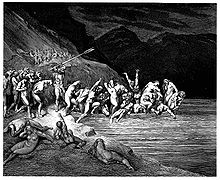Charon
[1][2] In Virgil's epic poem, Aeneid, the dead who could not pay the fee, and those who had received no funeral rites, had to wander the near shores of the Styx for one hundred years before they were allowed to cross the river.[5] Charon is first attested in the now fragmentary Greek epic poem Minyas, which includes a description of a descent to the underworld and possibly dates back to the 6th century BC.[6] No ancient source provides a genealogy for Charon,[7] except for one reference making him a son of Akmon (father of Uranus) [de], found in the entry "Akmonides" in the lexicon of Hesychius, which is dubious and the text may be corrupt.[10] The idea appears to have originated from the similarity between the names "Charon" and "Chronos" (a connection already made by earlier writers such as Fulgentius), the fact that both are said to be very old, and that the god of old age is said to be the child of Erebus and Night according to Cicero's De natura deorum.[12] In the 1st century BC, the Roman poet Virgil describes Charon, manning his rust-colored skiff, in the course of Aeneas's descent to the underworld (Aeneid, Book 6), after the Cumaean Sibyl has directed the hero to the golden bough that will allow him to return to the world of the living: There Charon stands, who rules the dreary coast;A sordid god: down from his hairy chinA length of beard descends, uncombed, unclean;His eyes, like hollow furnaces on fire;A girdle, foul with grease, binds his obscene attire.Though named after Charon, the Etruscan death-demon Charun has a different origin and functions, being an assistant to Death as well as psychopomp and guardian, delivering the newly dead to the underworld by horseback or chariot.




Charon (moon)Charon (disambiguation)Chironred-figurelekythosGreek mythologyAncient GreekpsychopompGreek underworldAcheronCharon's obolsmythemeviaticumVirgilAeneidHeraclesAeneasproper nounDiodorus SiculusMinyasgenealogyHesychiusPauly-WissowaDaremberg and SaglioGenealogia Deorum GentiliumItalian RenaissanceGiovanni BoccaccioErebusChronosFulgentiusgod of old ageCiceroDe natura deorumThanatos PainterMichelangeloThe Last JudgmentSistine Chapelart of ancient GreeceHermesRoman poetdescent to the underworldCumaean Sibylthe golden boughSenecaLucianDivine ComedyGustave DoréDante AlighieriInfernoGrim ReaperGustave DoreJoachim PatinirJose Benlliure y GilCharunAeacusAngelosAscalaphusCerberusCeuthonymusErinyesEurynomosHecateHypnosMelinoëMenoetiusMoiraiPersephoneRhadamanthusThanatosZagreusAsphodelMeadowsCocytusElysiumFields of sorrowFortunate IslesLand of dreamsPhlegethonTartarusDanaïdesSalmoneusSisyphusTantalusTitansTityusDionysusOdysseusOrpheusPirithousPsycheTheseusPausaniasPindarAeschylusEuripidesCallimachusPropertiusStatiusCharondwarf planetCharonosaurusCoins for the deadIsle of the DeadSymbolistArnold BöcklinManannán mac LirIrish mythologyManunggul JarTabon CavesPalawanPhlegyasInferno (Dante)UrshanabiMesopotamian mythologySuidasDictionary of Greek and Roman Biography and MythologyCharon's obolA Greek-English LexiconFolkloreJohn DrydenRonnie H. TerpeningTerpeningvase paintingsThe New York TimesComptes Rendus de l'Académie des SciencesJagiellonian UniversitySmith, William